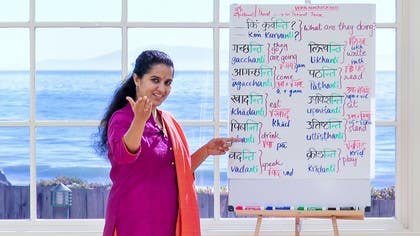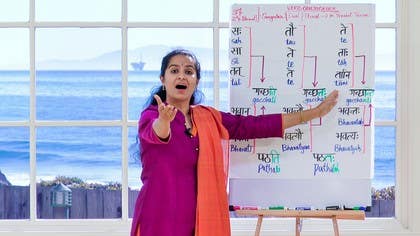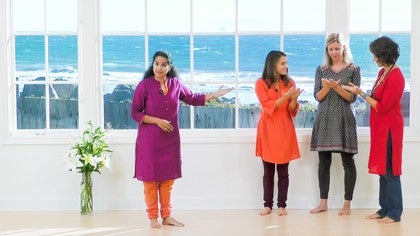Description
About This Video
Transcript
Read Full Transcript
Haryom and namaste again. I hope you are beginning to get a hang of the way the verb is conjugated in the present tense. We have looked at the third person singular and seen that the verb gets tea at the end. So gachatthi, khadatthi, peebatthi. Then we moved on to the dual case.
And in the dual case, the e disappeared and was replaced by the ah. So gachatthi, khadatthi, peebatthi. Next we will move on into the plural. We had our beautiful ladies demonstrate them for us. So we are already familiar with the sound of the way these verbs are conjugated.
And if you remember, it takes the nthi with it. So the question when many people are doing an action, many people third people out there, or it can also be in the second person formal. So when it's many people there doing it, or it can be here, but it's third people, then it would be kim kurvanti, kim kurvanti, close your eyes. Kim kurvanti, khadatthi. Now look at what it appears to be.
So kim kurvanti, khadatthi. English is the transliteration is rather simple. So kur is represented by the c on top of the head of the verb. That's the next consonant that follows. And then n and because the t has a short e, remember you just need to prepare for that when you're writing it out.
So you have to make or rather you have to write that stick there, draw the stick and then put the e, the antenna on the head of the third. So kim kurvanti, lovely. What are they two doing or you two formal doing? Kim kurvanti, the answer, those, all of them, many more than two, going, gachanti. And like we saw the present tense can also mean the simple present like they go or it can also represent the present continuous, they are going, got that.
So gachanti, gachanti, gachanti. See that, gachanti, got that, gachanti, lovely. The root that we've been exploring of the verbs for gachanti is gum, yes. And in transliteration, gum, lovely. The next is, they come, so maybe that's an easy way to actually remember the root of the verb because gum is to go, come is to come, you're playing with the English and the Sanskrit there a little bit, alright.
So if you remember come, just remember that the verb to go in Sanskrit, the root verb is gum, alright, that might help. So when we talk of aa, gachanti, say that aa, gachanti, yourself, say it, you would write it out as aa, gachanti and therefore we have the prefix aa plus the root gum, aa plus gum, nice. Now they eat, alright. So they eat, let's turn these pens into food, te kadanti, see that, kadanti, once more, kadanti, kadanti, kadanti, lovely. The verb of it, the verb root of this is very simple, it would be khad, great.
You've noticed the pattern, we have the nthi, nthi, nthi, the singular verb conjugation had t in it, gachati, when you have numerous people doing it, you get the numbers in, you just add the n of the number inside that. So gachati, put in the n of the numbers, it becomes gachanti, that's the way to remember it. Alright, when one person, gachati, as in one person, third person, gachati, many of them, the difference is in the numbers. Take the key of the numbers or rather the first letter, n and put that into the verb, so you will get gachanti, got that, fantastic. So peebati will become peebanti, they drink, peebanti, peebanti, you should become an expert at writing nthi after that, eyes closed in the middle of your sleep, anybody wakes you up, you should get this nthi correct by the end of the chart.
Alright, we have peebanti and the root is a slightly different one, it's pa, pa, pa, so pa becomes peebanti, to speak, got it, they speak vadanti, they speak, in Sanskrit the day in the masculine becomes te, te vadanti, vadanti, say that, very good. The root of that is vad, simple root, vad, great, they write lykhandi, lykhandi, lykhandi, fantastic, do you remember the root, great, lyk, lyk in transliteration, lovely, they read padhandi, padhandi, padhandi, padhandi, that's it, remember the root again a simple one, so paat, now that in Devanagari it's paat and in transliteration that would be paat, lovely. Then our favourite, one of our favourite words, to sit down, after a lot of work it's a nice idea to just sit down and you can sink into the word, so upavishanti, upavishanti, upavishanti, the upavishanti, fantastic, remember the fact that the verb is composed of a prefix upa, we have upa plus the verb wish and then you make it upa plus wish, they said upavishanti, very good, they stand uttishtanti, uttishtanti, uttishtanti, uttishtanti, make sure your tongue rolls up for that second th, uttishtanti, very good, the root being stha and it has the prefix utt to it, sorry, utt plus stha, utt plus stha and in transliteration utt plus stha and then the fun verb is to play, they play kridhanti, kridhanti, kridhanti, kridhanti, the root being a simple one is kreedh, very good, kreedh, that's it, alright, so you're there with me till now, let's repeat all of that once, I say it, you think of it and you repeat it, alright, there we go, so those many of them as well as you formal many of them are doing the action, remember that, what are they doing or what are you formal doing, kimkurvanti, kimkurvanti, they are going, te gachanti, very nice, they are coming, agachanti, fantastic, they are eating, khadanti, khadanti, once your turn, lovely, they are drinking, peebanti, very nice, they are speaking, vadanti, fantastic, they are writing, leekhanti, fantastic, they are reading, padanti, very good, they are sitting, upavishanti, lovely, they are standing up, uttishtanti, fantastic and they are playing, in India cricket is a favourite game, so play, kridanti, fantastic, alright, so feel free to leave me any comments if there is anything complicated that you have not got and I'd be more than happy to be there to help you with it, enjoy practicing this and I'll meet you in the next session where we look at the second person, singular, dual and plural in the informal with the verb conjugations.







You need to be a subscriber to post a comment.
Please Log In or Create an Account to start your free trial.